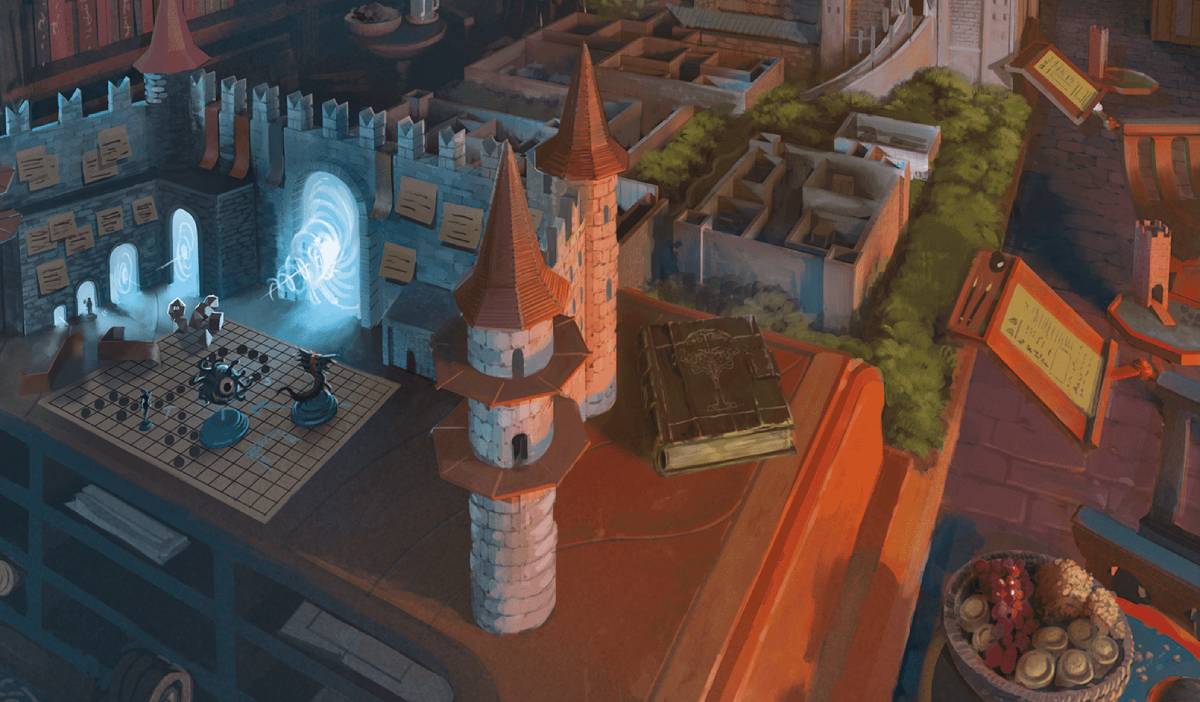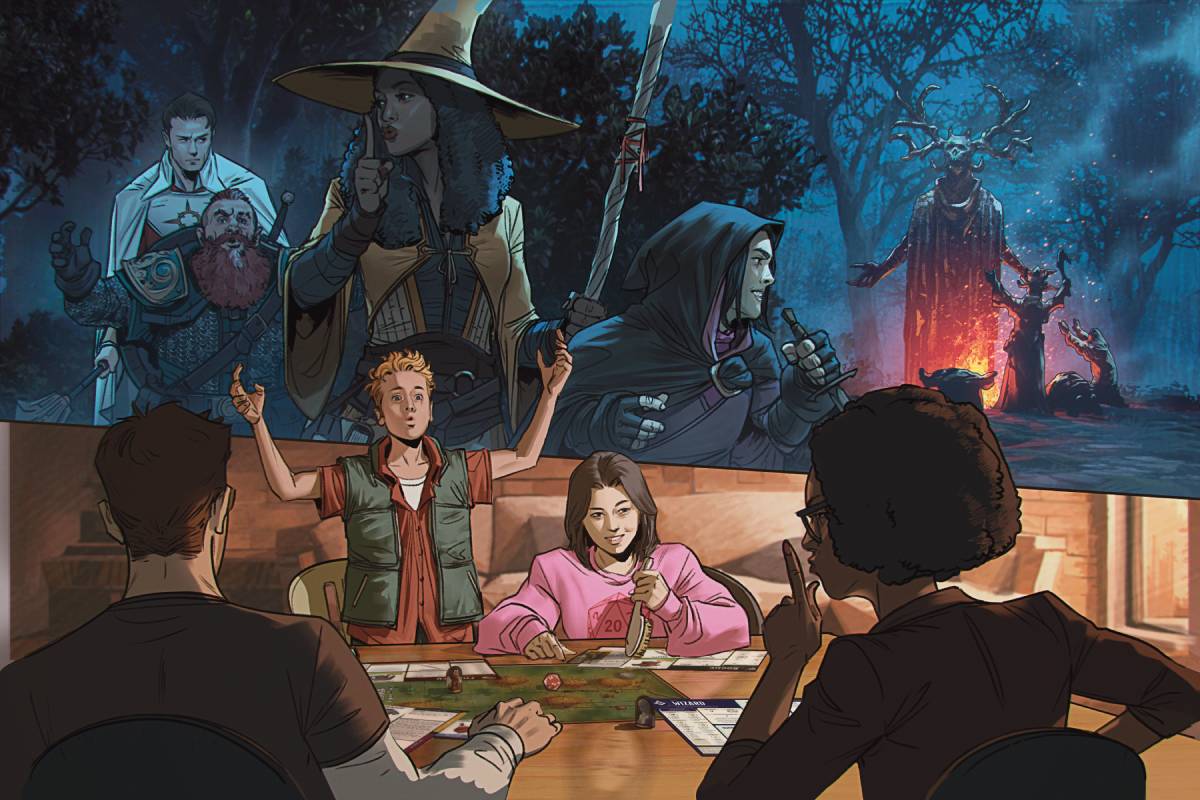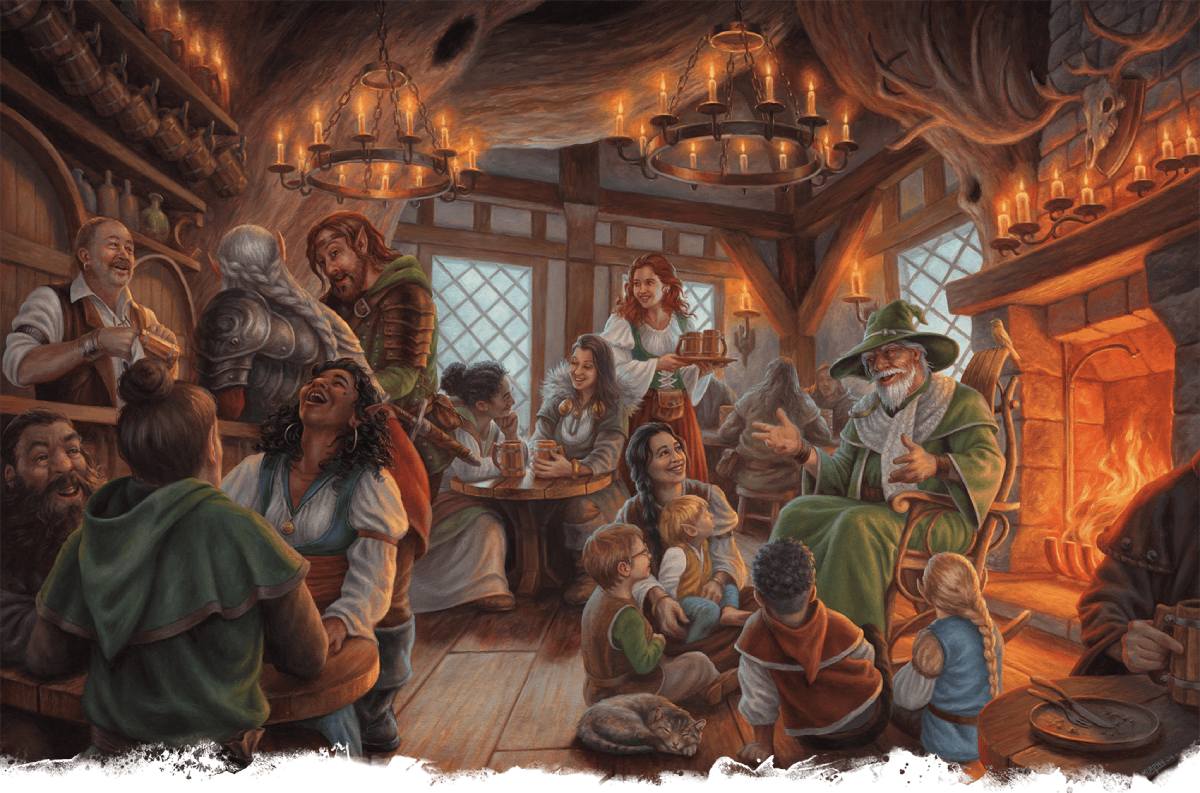To adventure in all of the epic worlds that Dungeons & Dragons unlocks, all you need is a Dungeon Master, players, some dice, and a spark of imagination. But what if you're a Dungeon Master who's got the dice and the imagination… but no players?
In this article, we'll walk you through how to turn your friends and family from curious onlookers into dice-rolling, story-shaping heroes with nothing but the right frame of mind (and maybe a few snacks).
- Finding the Right Group
- Starting Off on the Right Foot
- Providing the Right Atmosphere
- Evaluate How It Went and Get Player Feedback
Finding the Right Group

Your first quest is simple: much like Gandalf gathering a motley crew of adventurers, you must find your party.
Look around. Your next D&D crew might be closer than you think. Co-workers, classmates, neighbors, or family members can all make great recruits. You don't need a table full of fantasy experts; in fact, newcomers to the space often bring fresh energy and wild ideas of their own.
Need More Help Finding Players?
- Wizards Store Locator: Check your friendly local game store—many host tables or are looking for Dungeon Masters to run sessions in-store.
- StartPlaying: This platform can connect you with players looking for a game. The best part is, since the sessions are remote, distance isn't an issue!
How to Invite Your Friends to Play D&D
You've got your sights set on potential D&D players. Maybe they referenced Star Wars one time. Maybe you've played Catan or Betrayal at House on the Hill together. Or, maybe they're just open to a new experience.
If you know what media they're into, you can give them a thematic pitch to pique their interests:
- Maybe they're a Marvel fan, so you send them the video of Deborah Ann Woll (Karen Page from Daredevil) teaching Jon Berthal (AKA "The Punisher") how D&D works.
- Or maybe you know they've played RPG video games like Baldur's Gate 3 in the past, so you hook them in with, "How would you like to go on your own adventure like the one that Astarion, Gale, and Karlach underwent?"
Otherwise, you can hit them with a generic, "It's kind of like a board game. You control a character, and roll dice to determine the outcome of situations!"
Starting Off on the Right Foot

Before you start playing, remember that new players don't need to know everything about D&D to play. Here are some methods I like to use to introduce newcomers:
1. No Character Sheets, Just Dice and Vibes
Some new players, especially those without RPG or board game experience, may be overwhelmed when looking at a character sheet, discussing modifiers, and learning about ability checks vs saving throws.
For these players, I like to play my first "session" just by simply improvising a scene, such as entering a seedy tavern or exploring a mysterious forest, without any stats—just some dice that help decide the outcome.
If the story leads to a fight, introduce just enough mechanics to handle it: give each player a basic Armor Class, a small pool of Hit Points, and a weapon that deals a fixed amount of damage. Show them how to roll for Initiative and explain attack and damage rolls as they happen.
It's easy to pick up the game when you pare it down to, "Roll this d20 to help decide the outcome of your action."
This style of play is barebones by design, but it's a good setup for layering in structure once your players are ready.
2. Introducing the Game in Structured Steps
Players who are interested in combining mechanics with imagination may want something more structured than an improvised scene, but they don't necessarily need to be thrown into the deep end.
This can easily be done by providing premade character sheets and smoothing over some of the more complicated aspects of the game.
This is also where the Heroes of the Borderlands starter set thrives. All you have to do is crack open the box and start playing. Players don't worry about what Point Buy is or what a Hit Die does.
Maybe they want to be a heavily armored warrior who protects their friends, a sneaky rogue who's adept at finding hidden doors, or a spellcaster who conjures fire bolts to throw at their enemies. From there, you can place a class board in front of them, let them choose their origin, and say, “You're ready to play.”
Each board is intentionally designed to teach the game in pieces. It quickly shows the player, “You have 8 Hit Points. If you take damage, you remove Hit Point tokens from your board. Here's how resting works and how it helps you regain Hit Points.”
Instead of front-loading complexity, it allows you to meet the players where they are.
- Want to attack? Roll this dice and add this number. If it hits, roll the damage on your Longsword card.
- Want to cast a spell? Remove a Spell Slot token and follow the card.
- Want to know your Armor Class? It's right here in big bold letters on your Plate Armor card.
Your Table. Your Approach.
I like these approaches because you don't begin a player's D&D experience with bookkeeping, a lecture on rules, or a lore dump. The first thing they learn to do is put themselves in the character's shoes and make decisions that shape the story.
You know your players and can better anticipate how they'll best learn the game. You can try these approaches, spin off variations, or use an entirely different strategy!
Providing the Right Atmosphere

Keep it Casual
The stories we tell when playing D&D can sometimes be as heartbreaking and profound as they can be joyful and light. Adventures with first-time players are likely at their best when they have fun or silly elements. As always, the level of levity your table is comfortable with will depend on your players and can even be discussed ahead of time.
Likewise, when playing with my weekly group, we know there's time for catching up and small talk when everyone is getting settled, then it's time for the recap and jumping into the game.
New players, on the other hand, may be more chatty before the game and have to be corralled into starting. They may also need a break from the flow of the game more often; it's important to give them the freedom to slip out of character. Even if things are chugging along, I tend to pause every 30 minutes to 1 hour and let everyone have a breather or talk about what's been happening.
Visual Elements
Most people are used to visual and tactile elements in their entertainment, whether it's a book, board game, video game, or movie. While D&D can run on imagination alone, props can help newcomers feel grounded.
Visual aids could be as simple as white grid paper and paper tokens, or as complex as 3D terrain and painted miniatures to represent characters and monsters.
If you want to take the guesswork out of preparation, the Heroes of the Borderlands starter set is here to help. Almost everything players interact with has a physical component. Monsters and characters have punch-out tokens for the printed maps. Players remove Hit Point tokens from their board when they take damage. If they need to check a spell or magic item, the info is on a card right in front of them.
This tangible setup smooths the path between “playing a game” and “imagining a world.”
Use Snacks
Snacks are usually a good enough reason to get me out of the house on most days. A well-fed table is a happy table, so when teaching people D&D, snacks are your best friend.
Evaluate How It Went and Get Player Feedback
When the game wraps, ask your players what they enjoyed most, what confused them, and if they'd like to play again.
You can also jot down a few things you want to cover before the next session, be it a recap of the first session, character creation tips, gameplay rules, snack schedule, or any other things you'd usually bring up at a session zero.
Same Time Next Week?
Whether you're using Heroes of the Borderlands or your own methods to nurture curiosity into full-blown storytelling and camaraderie, the goal is the same: make that first step magical and ignite their imagination.
Start small, keep it simple, and before long, you won't just have friends or family who tried D&D; you'll have a band of intrepid adventurers ready to brave dungeons, defeat—or befriend—dragons, and write their own legendary tales.

Mike Bernier is the founder of Arcane Eye, a site focused on providing useful tips and tricks to all those involved in the world of D&D. Outside of writing for Arcane Eye, Mike spends most of his time playing games, hiking with his partner, and tending the veritable jungle of houseplants that have invaded his house.








-
View User Profile
-
Send Message
Posted Aug 7, 2025First! The strategy I use when introducing new players is usually showing them a blank character sheet and explaining the basics, then asking them if they have an idea on what they want to play as. Some of the slower options seem like you're treating your players like babies who can't understand anything.
-
View User Profile
-
Send Message
Posted Aug 7, 2025I actually used Adventure Begins. It's a bit too simple but it's a fantastic way to show how to roleplay. Which all these kids actually enjoy playing a lot.
-
View User Profile
-
Send Message
Posted Aug 7, 2025THIS ARTICLE IS AWESOME!!! THANK YOU SO MUCH FOR THAT INFORMATION!!! SO USEFUL!!! 😀😀😀😀😀😀😀😀😀😀😀😀😀😀😀😀😀😀😀😀😀😀😀😀😀😀
-
View User Profile
-
Send Message
Posted Aug 7, 2025thats useful
-
View User Profile
-
Send Message
Posted Aug 7, 2025true
-
View User Profile
-
Send Message
Posted Aug 7, 2025i saw this and was like "finally, a post that's not just stuff about new products!" then i saw the stuff on heroes of the borderlands and realized that wizards got me this time
-
View User Profile
-
Send Message
Posted Aug 8, 2025Good advice. Bear in mind that indecisive or anxious players might feel overwhelmed by showing a blank character sheet and explaining even just the basics. When I introduced family, I used that method as it was the one most often described to help players get started with things like the Essentials Kit, and you could see the enthusiasm drain away. “Why do I have to do paperwork to play this?” I like this article as the Keep it Casual method is straightforward and doesn’t clutter the game with often irrelevant rules, which can spoil the fun for new players. Love the shout-out to the “How D&D Works” video.
-
View User Profile
-
Send Message
Posted Aug 9, 2025Is taking StartPlaying or Jon Berthal's podcast as reference part of the new D&D team's initiative?
-
View User Profile
-
Send Message
Posted Aug 9, 2025I simply love this and suppose I am a natural where this is concerned because I would not do anything different! Easy button. But I already see it in the critics below that there are many approaches. But after all is said and done, if you want the player to be interested in coming back next time, it must be completely about THEM and not the GM.
-
View User Profile
-
Send Message
Posted Aug 11, 2025Most of this is fine advice, however, please do not do the "no character sheet and vibes." Someone did that with me and I didnt play dnd for the next 15 years because I thought dnd was so dumb with no rules. After playing correctly I was completely hooked after a single session.
-
View User Profile
-
Send Message
Posted Aug 11, 2025Very useful. Will keep in mind.
-
View User Profile
-
Send Message
Posted Aug 11, 2025Yeah, I was suspicious of that approach when I saw it. Thanks for the feedback.
-
View User Profile
-
Send Message
Posted Aug 11, 2025haha I know right
-
View User Profile
-
Send Message
Posted Aug 13, 2025wizards you sly dog
-
View User Profile
-
Send Message
Posted Aug 19, 2025Yes, I think it's almost always going to be a better option to give characters premade character sheets and a picture of what their character looks like to get their imagination going and let them know that there is detail waiting for them when they want it. You can just let them know that they don't need to stress about knowing what their character sheet means for now, and as you move through the game and things on the character sheet become relevant, you will draw it to their attention.
-
View User Profile
-
Send Message
Posted Aug 21, 2025My favourite method is to say "you gamble, you gamble everything, its literally gambling wrapped in a shiny elven cloth", works everytime
-
View User Profile
-
Send Message
Posted Aug 26, 2025are you sure that would work?
-
View User Profile
-
Send Message
Posted Aug 26, 2025For Real
-
View User Profile
-
Send Message
Posted Aug 27, 2025When talking about characters with new players, I like to start by saying "do you have a favorite character from Lord of the rings, or the stormlight archive who you would like to play?" This usaully helps get them into the game, and start learning the basics. In addition, if they wanted to be Gimli, they already know what to roleplay (if they are up to it)
-
View User Profile
-
Send Message
Posted Aug 27, 2025Honestly, thats a great idea